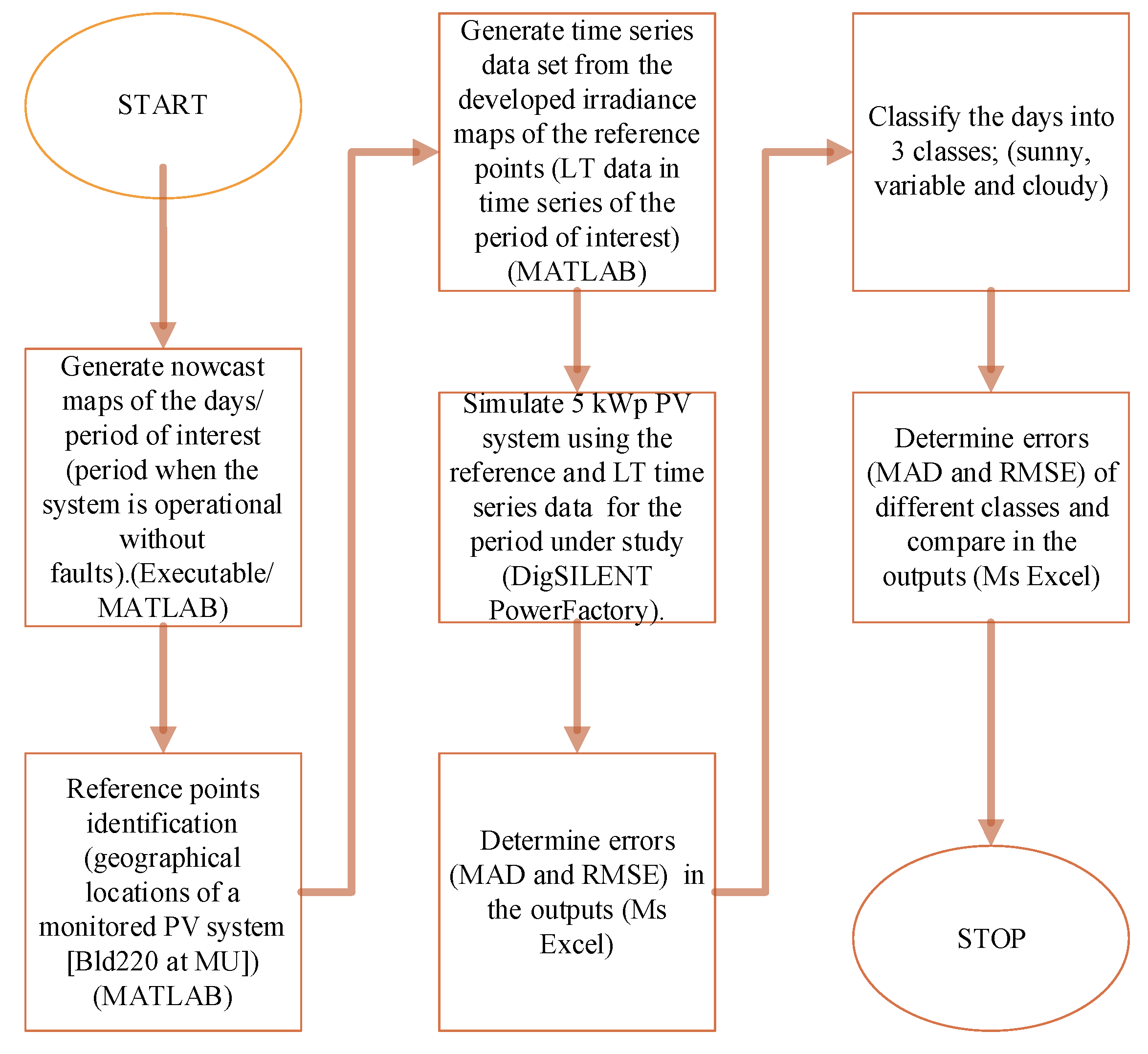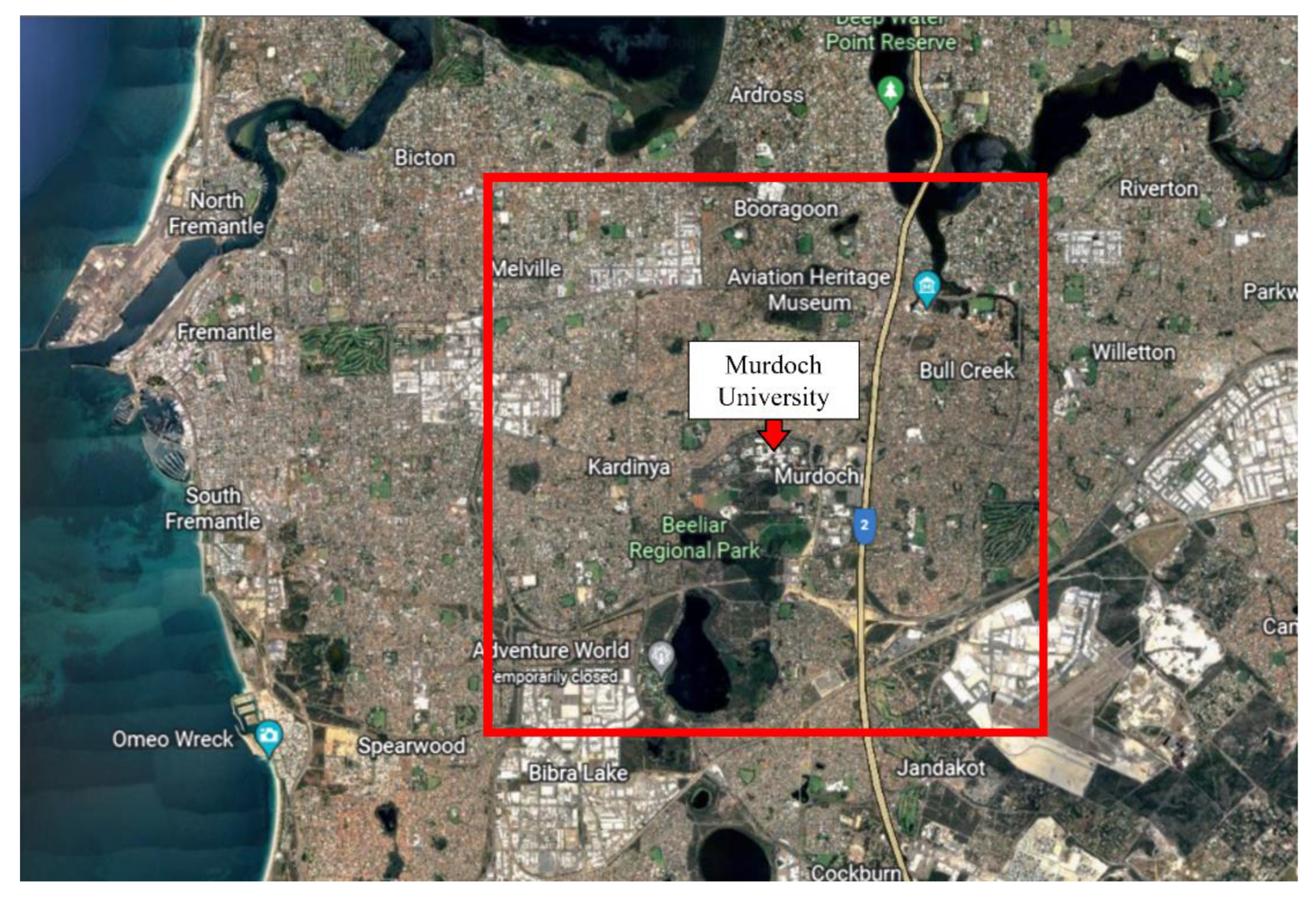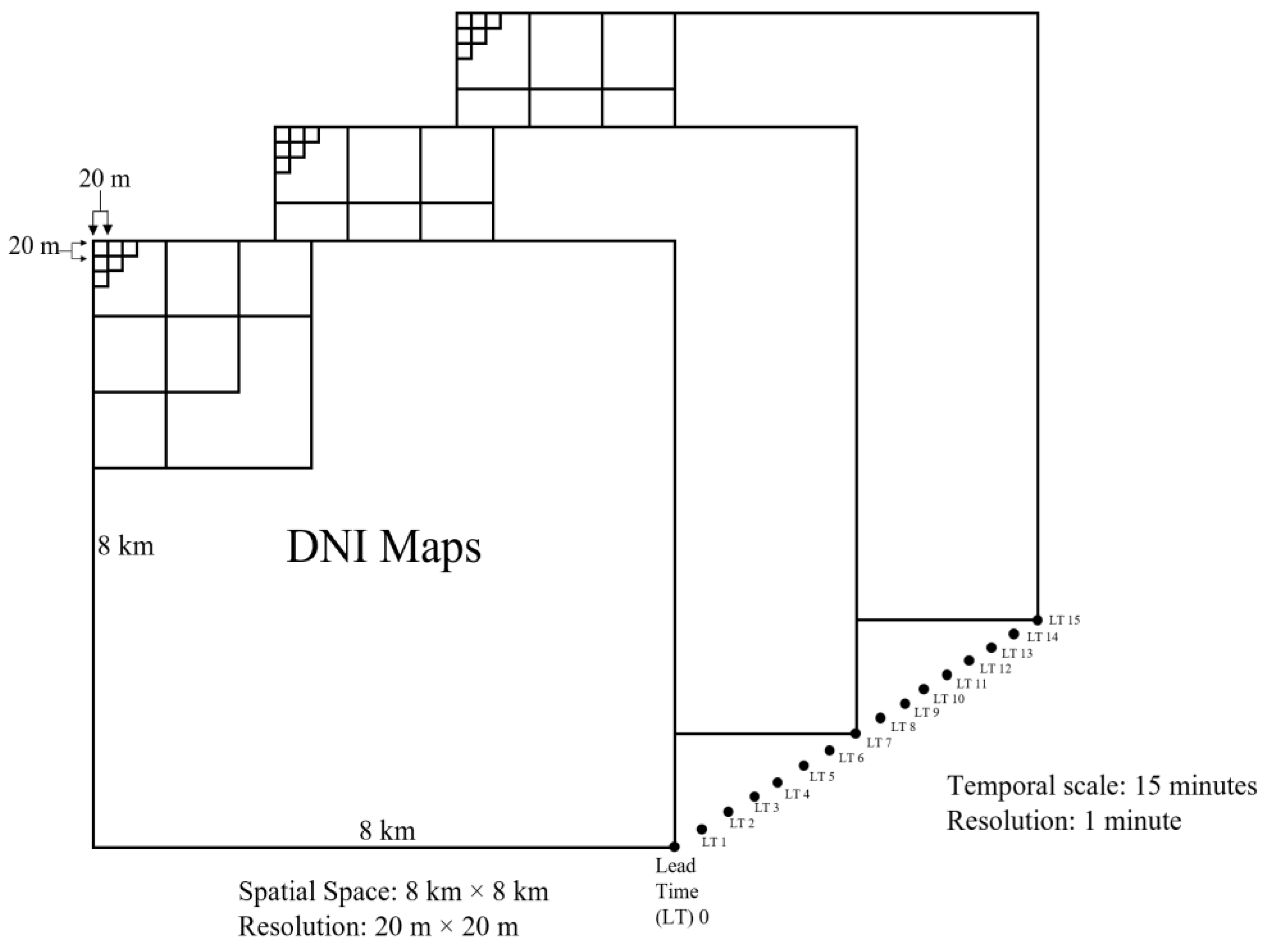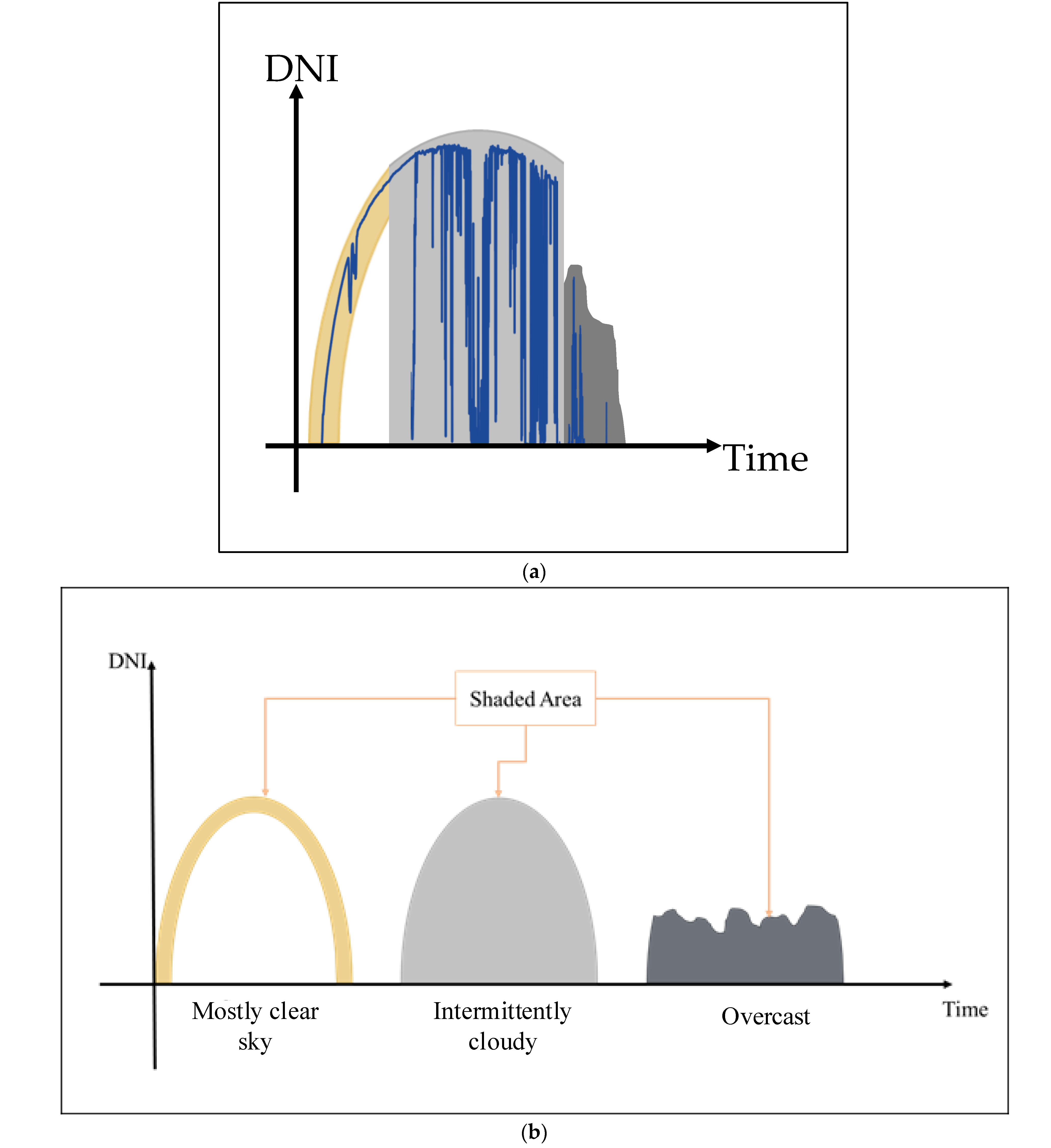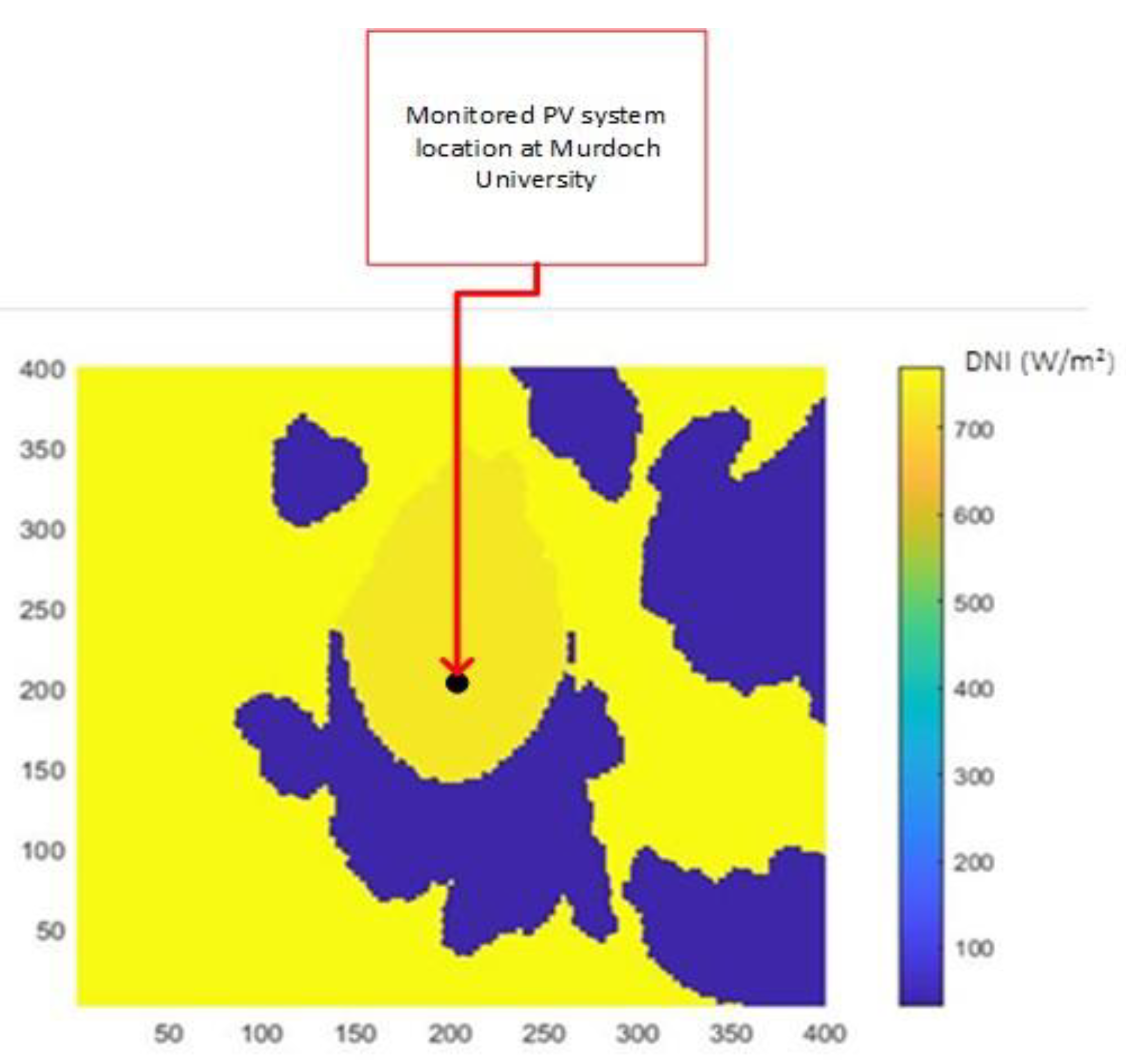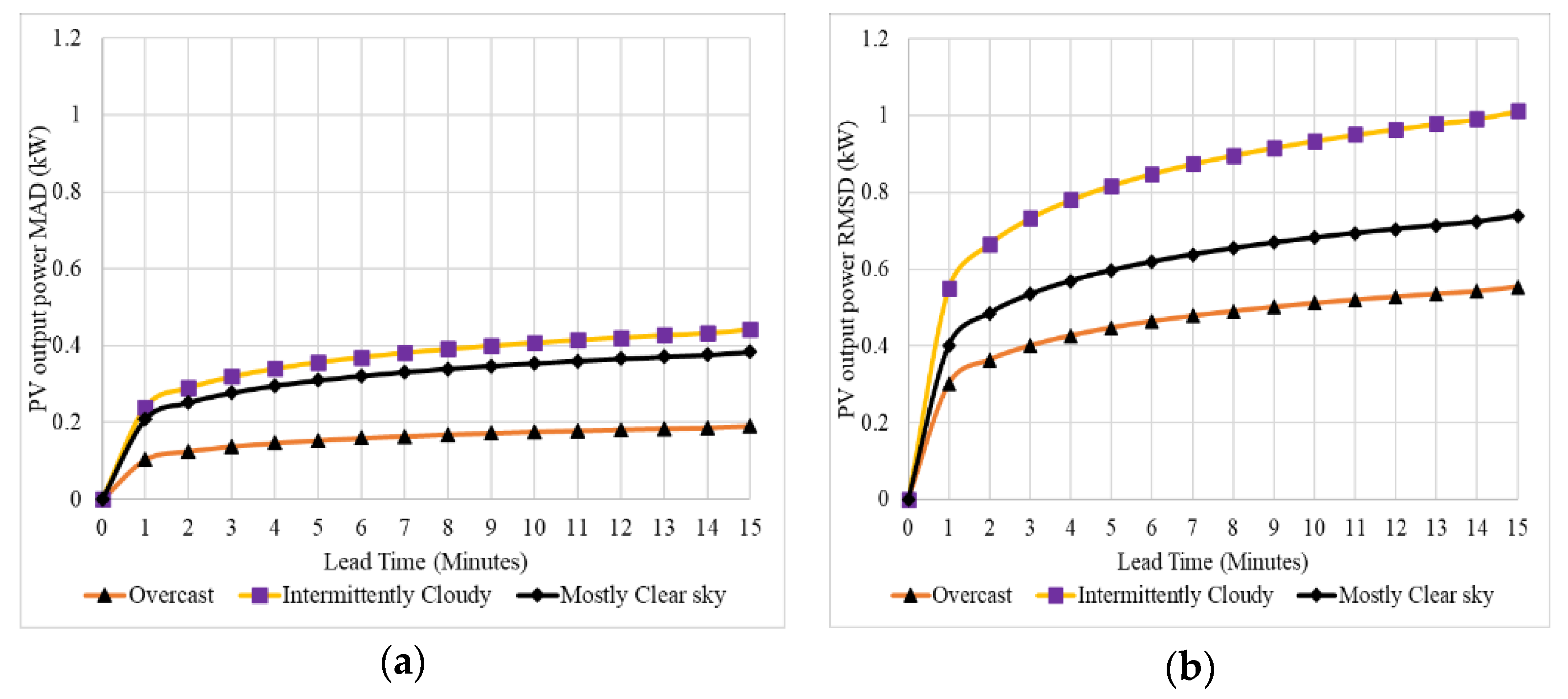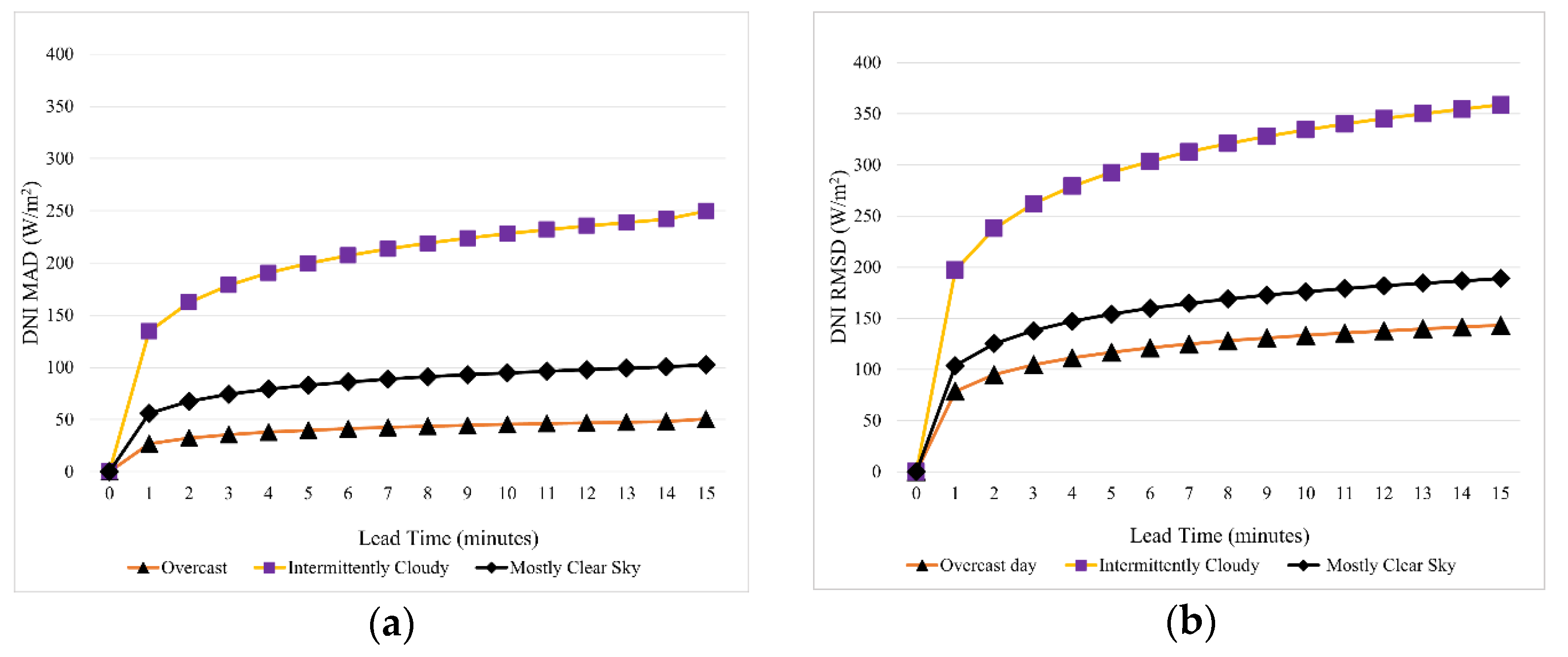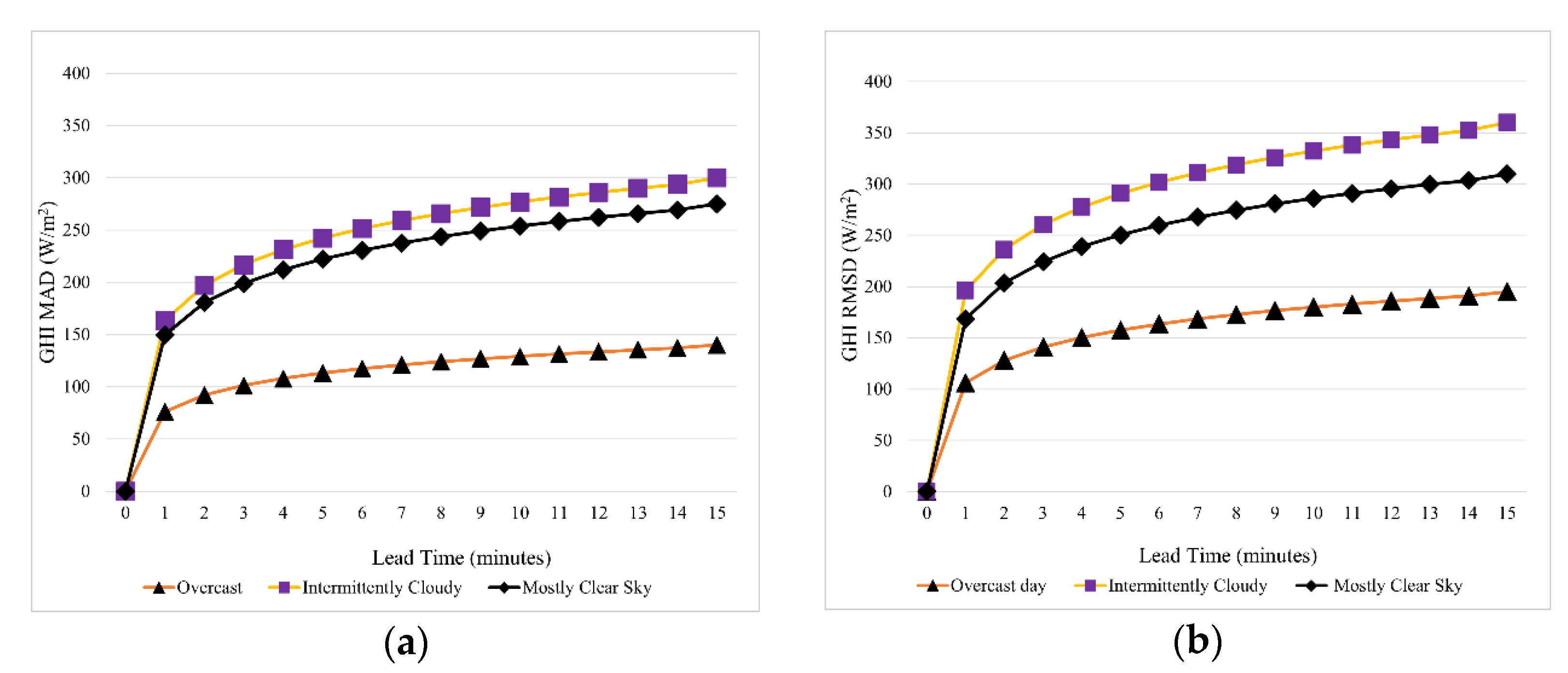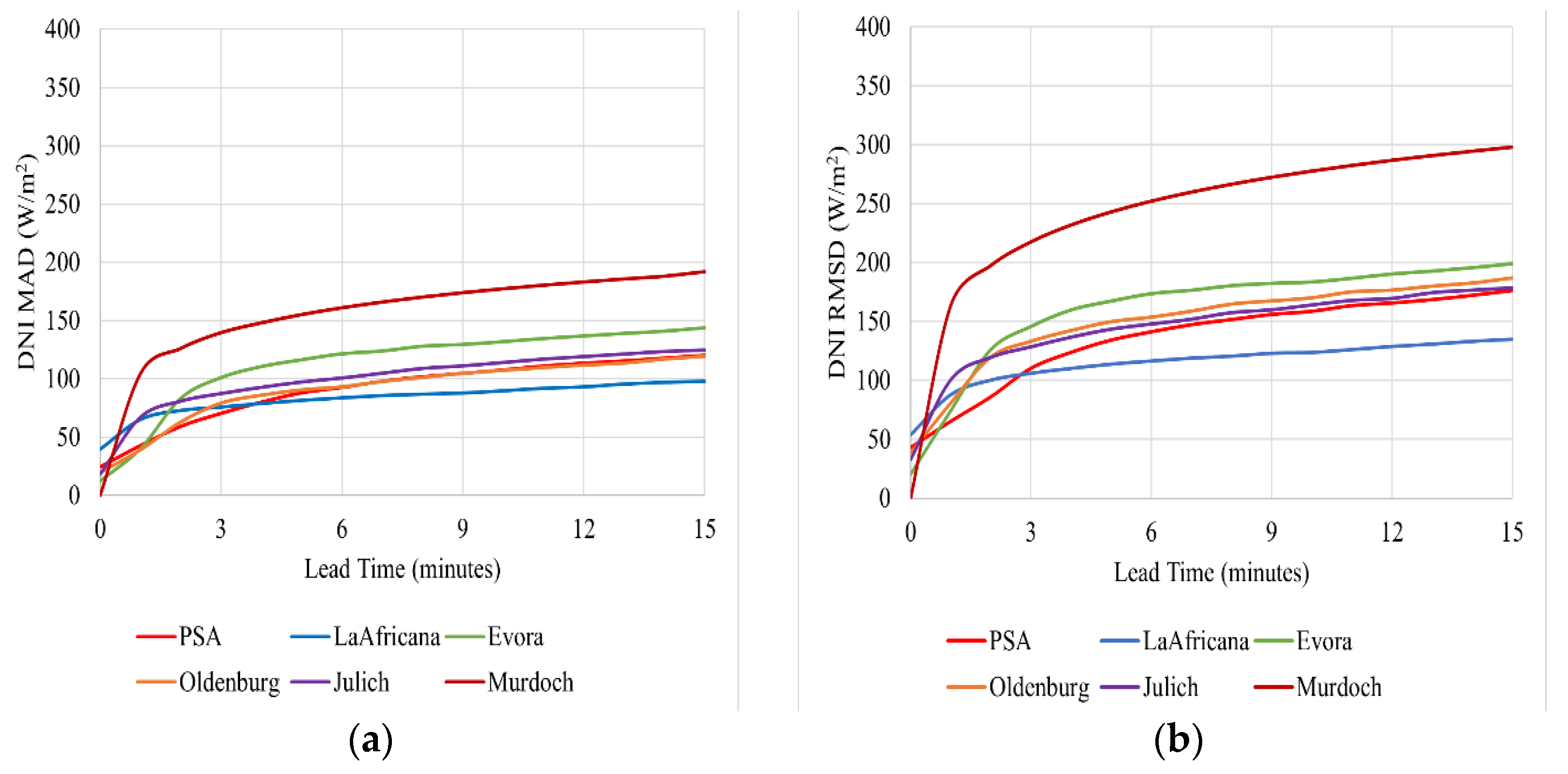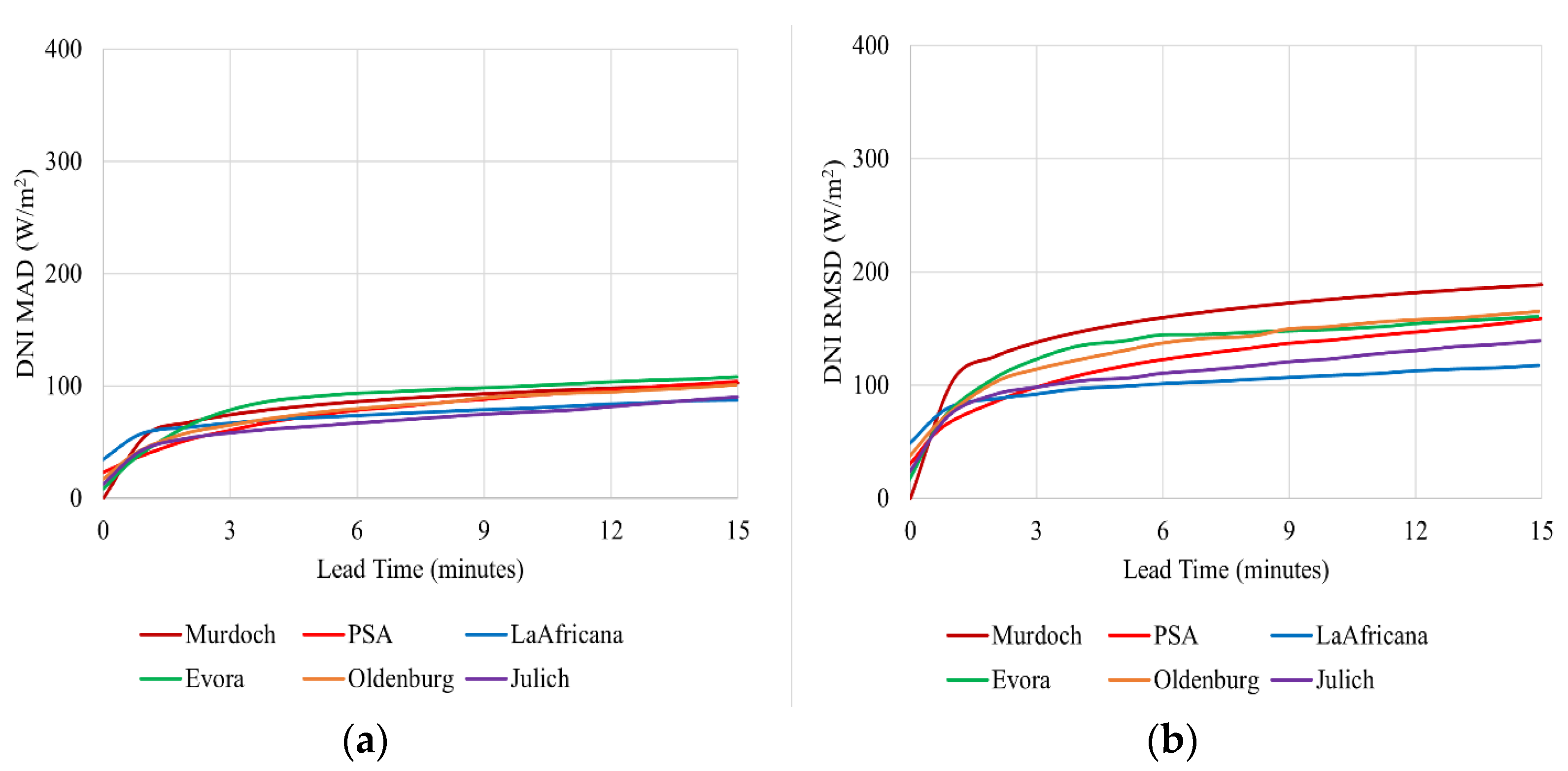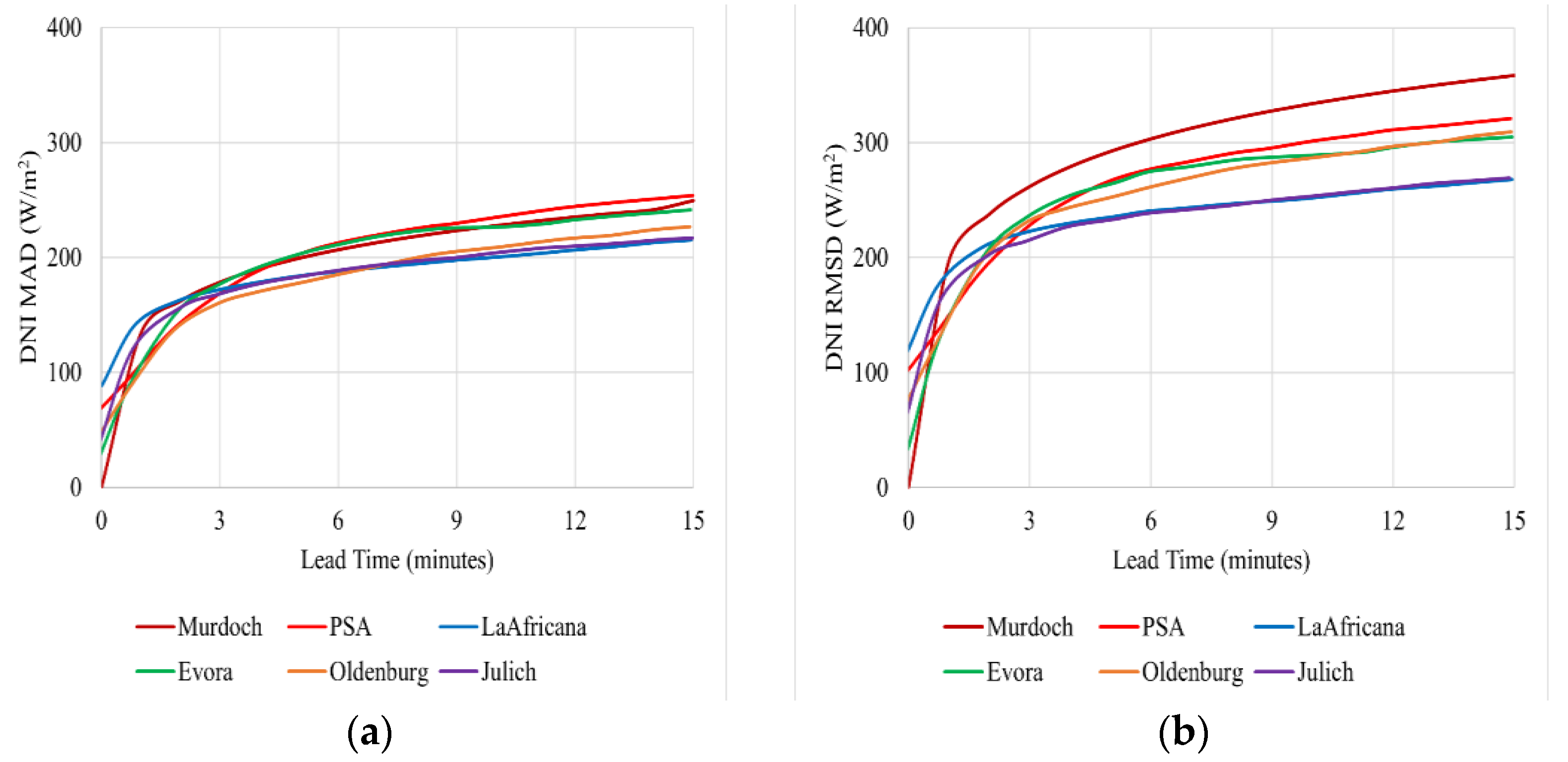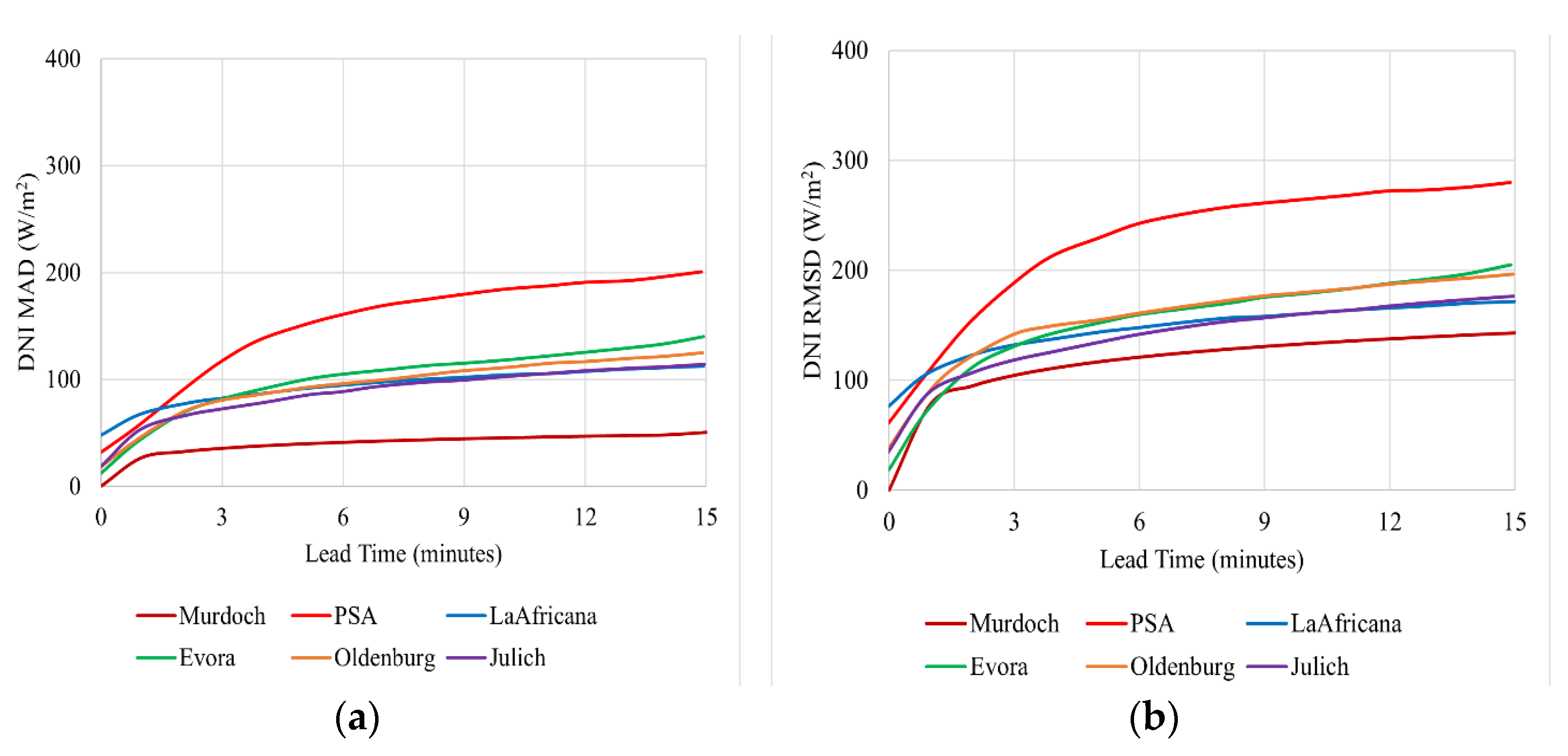2. An Overview of the Used Nowcasting System Set-Up
Two MOBOTIX Q26, 6 megapixels (MP), fisheye lens surveillance cameras are utilized as ASIs at Murdoch University, Perth Campus in Western Australia.
Table 2 presents the technical details of the measurement equipment [
31,
32] and location details of the ASIs, which are mounted 640 m apart from each other and other nowcasting system components. The fisheye lenses of the cameras produce 180° × 180° hemispherical images encapsulating the viewable sky from the camera location. Set to the maximum image format of 6 megapixels (3072 × 2048), the cameras capture images every 30 s.
A ground-based meteorological station at Murdoch University also forms part of the nowcasting system. The flow diagram in
Figure 1 summarises the configuration and processing chain, whilst
Table 3 summarises the steps involved in the processing chain of the nowcasting system applied in this study.
Figure 2a,b shows a MOBOTIX Q26 ASI mounted at Murdoch University and an example of a sky image taken by the ASI, respectively.
For evaluating nowcasts, high-resolution solar irradiance data are required. At least one DNI measurement sensor needs to be installed adjacent to one of the ASIs for evaluation purposes. In this study, a Kipp and Zonen CHP1 pyrheliometer used for DNI measurements is installed on a Kipp and Zonen SOLYS2 sun tracker which is mounted less than one meter from the ASI 2. In addition to the DNI, the diffuse horizontal irradiance (DHI) and GHI are also recorded. Kipp and Zonen CM11 pyranometers are used for this purpose. A DT80 Series 2 data logger is used to sample and record the irradiance and temperature measurements from the pyranometers and pyrheliometer.
Network, Connectivity and Storage
The ASI system at Murdoch University comprises two ASIs and a datalogger connected via ethernet on a local area network. The sky images and irradiance measurements are stored via the FTP to a server. The Mobotix cameras are both hardwired for power via a power over ethernet power supply, whilst the data logger and the SOLYS2 are hardwired with a regulated 24 V DC supply. The maintenance of the cameras and irradiance sensors is carried out periodically with a set schedule and maintenance log kept for consistency and fault finding.
Figure 3a,b shows the complete setup at the Murdoch University location. The geographical coordinates of these components are presented in
Table 2.
4. Results and Discussion
To evaluate the operation of the nowcasting system under Western Australian conditions, models were developed, and this section reports the outcomes of the analysis.
Figure 8 is a three-dimensional virtual modelling space with cloud models and a topographical map around Perth with spatial DNI information generated at a 30 s resolution. This resolution corresponds to a 30 s resolution at which the sky images are logged as inputs for the generation of the irradiance maps. These maps cover a surface area of 64 km
2 (8 km × 8 km). The Z-axis in
Figure 8 shows the cloud height at the location of the study. Cloud height is of importance as it determines how far into the future an irradiance forecast can be determined.
Figure 9 is a two-dimensional exemplary nowcast DNI map also covering a surface area of 64 km
2. In two dimensions, these maps are displayed via 400 × 400 pixels, with each pixel representing certain geographical locations of 20 m × 20 m. From
Figure 8, it is observed that at the instant when that DNI map was captured, the day was partly cloudy. The geographical location of the monitored PV system (
Figure 9) on top of Building 220 is 32.06613° south, 115.8371° east.
Figure 10 shows a sample output from the simulation displaying the PV power in kW. It is observed that the output power is consistent with the input irradiance in the PF PV model. From
Figure 10, it can also be seen that there is an increase, then a decrease in the output power as the day progresses, from 6 am to 6 pm. Additionally,
Figure 10 displays sample PV power outputs due to LT0 (measured irradiance data at the time of the nowcast LT7 value) and due LT7 (nowcast of 7 min ahead). It is observed that days 1, 3, 4, and 5 are mostly clear sky days, whilst day 2 is intermittently cloudy. It is seen that the errors are minimum on mostly clear days to intermittently cloudy. This is denoted by the almost overlapping of power (LT0) and power (LT7) curves in mostly clear sky days as opposed to intermittently cloudy days. The overlapping of the plots shows the matching between the measured PV output power and the nowcast PV output power.
Table 7 shows the distribution of the days under analysis.
Figure 11a,b displays the 5 kWp PV system output power MADs and RMSDs, respectively. The lowest deviations are observed in class 1 (with an LT15 MAD of 0.38kW), which represents mostly clear sky conditions, and class 3 (with an LT15 MAD of 0.19kW), which represents overcast, whilst the highest deviations are observed for class 2 (with an LT15 MAD of 0.44 kW), which represents intermittently cloudy conditions.
Figure 12 and
Figure 13 display the DNI MADs, DNI RMSDs, GHI MADs, and GHI RMSDs, respectively, for the same time frame as that of
Figure 11a,b, classified using the developed classification method in this study. The results displayed in
Figure 12 and
Figure 13 are consistent with those observed in
Figure 11a,b. As displayed in
Figure 12a, the lowest deviations are observed in class 3 (with an LT15 DNI MAD of 50 W/m
2), which represents overcast and class 1 (with an LT15 DNI MAD of 102 W/m
2), which represents mostly clear sky conditions whilst the highest deviations are observed for class 2 (with an LT15 DNI MAD of 250 W/m
2), which represents intermittently cloudy conditions.
From
Figure 14a, it is observed that the DNI MAD of the ASI system at Murdoch University is higher than the other five sites, and so is the DNI RMSD, as shown in
Figure 14b. The differences between the DNI MAD and DNI RMSD values at LT15 for the Murdoch University ASI system to the highest DNI MAD and DNI RMSD values of the other five sites are around 48 W/m
2 and 99 W/m
2, respectively. These differences could be mainly due to the evaluation periods of each site. PSA and LaAfricana were evaluated over a year whilst Evora, Oldenburg Julich, and Murdoch University, were evaluated for only 42, 86, 80, and 47 days, respectively, during a certain period of the year. Additionally, the evaluation period for Evora was during the summer period where rainfall is at its lowest with a majority of mostly clear sky conditions, whilst for Oldenburg and Julich, the evaluation was during a heavy rainfall period where the sky is mostly overcast. On the contrary, as shown in
Table 7, the ASI system at Murdoch University was evaluated over 47 days, with the majority of the days under evaluation falling under the intermittently cloudy class, which is associated with high errors due to high DNI variability.
A further performance evaluation of the ASI system at Murdoch University under different conditions was conducted. These conditions were classified into three categories; mostly clear sky, intermittently cloudy, and overcast. The DNI MADs and DNI RMSDs of each class were then compared to the other five sites.
Comparing the descriptions of the three classes presented in
Table 4 to the descriptions of the eight DNI variability classes by Nouri et al. [
25], in
Table 8, the three classes in
Table 4 were matched as shown in
Table 9. However, it should be noted that there are differences in the variability classification methodologies employed for the Murdoch University site and employed for the other five sites. For Murdoch University, the classification was conducted by determining the classes using hourly sliding windows over a day and recording the most occurring class as the overall class of the day as explained in
Section 3 of this study, whilst the classification of the other five sites involved the classification of every timestamp, using 15 min windows over a day and then categorising them as shown in
Table 8 [
25]. The matches in
Table 9 were formulated by summarising the eight classes in
Table 8 into: mostly clear sky (the sky is clear/almost clear, and the clear sky index is high), intermittently cloudy (the sky is partly cloudy, and the clear sky index is intermediate), and overcast (the sky is overcast/almost overcast, and the clear sky index is low). From the class descriptions, there is a possibility that classes 3 and 6 from
Table 8, could be fitted into classes 2 and 3 from
Table 4, respectively; however, in this study, these were matched as presented in
Table 9.
The DNI MADs and DNI RMSDs for classes 1 and 2 for Murdoch are showing an alignment with the results from PSA, La Africana, Evora, Oldenburg, and Julich, as shown in
Figure 15,
Figure 16 and
Figure 17. From
Figure 17a,b, it is seen that in overcast conditions (Class 3), the nowcasting system at the Murdoch University site displays the least DNI MAD and DNI RMSD of 50 W/m
2 and 148 W/m
2, respectively, whilst the DNI MAD and DNI RMSD for PSA for overcast conditions are relatively higher compared to the other six sites. The reason for this is that PSA is in a valley surrounded by mountains. When it is overcast, PSA records a lot of thin high layer cirrus clouds with complex multilayer conditions, resulting in higher uncertainties in cloud segmentation and tracking. Contrarily, when overcast, Perth observes low-layer stratus clouds, which are easy to process, resulting in a higher forecasting accuracy under such conditions.
The variations in DNI MADs and DNI RMSDs are also dependent on the sites’ proximity to the ocean, resulting in coastal cloud formations. The closer a system is to the coast, the higher the frequency of clouds, leading to increased intermittently cloudy conditions [
39,
40,
41]. To investigate the effect of the location of an ASI nowcasting system with respect to the coast, an analysis of LT15 RMSDs for the intermittently cloudy class was conducted, and the results are displayed in
Table 10. It is observed from
Table 10 that the LT15 RMSD decreases as the site distance from the coast increases, and these results are also complimented by
Figure 16b.
5. Conclusions and Future Works
The integration of nowcasting systems in the control of IMGs might enable increased PV penetration levels, reduced spinning reserve requirements, and reduced fossil fuel usage. Such a system is installed at Murdoch University. In this study, nowcasts of 47 days’ worth of data were utilised to evaluate the performance of an ASI nowcasting system at Murdoch University in Perth, Western Australia (WA). DNI and GHI maps with edge lengths of 8 km and lead times up to 15 min ahead were generated.
The RMSD and MAD values were calculated as functions of variability classes and lead times. A simplified classification model, comprising three classes was developed and used for the classification exercise. Both the MAD and RMSD are relatively low for classes 1 (Mostly clear sky) and 3 (Overcast) as opposed to class 2 (Intermittently cloudy days). These results are consistent as these two classes (1 and 3) display low temporal irradiance variability, whilst class 2 displays high temporal irradiance variability. From the trends outlined in these results, it could be concluded that the simplified developed classification model works comparable with the one with eight classes. Additionally, for the integration of nowcasting into the control of IMGs, the distinction between mostly clear sky, overcast, and intermittently cloudy conditions, is sufficient, thus complementing the applicability of the simplified model. The overall performance of the nowcasting system was therefore as expected as it is consistent with previous evaluations in five other different sites namely PSA, La Africana, Evora, Oldenburg, and Julich. As a limitation, it should be noted that for the ASI system at Murdoch University, the number of overcast days (class 3) is very low, 6, compared to 17 and 24 for classes 1 and 2, respectively. Additionally, a performance comparison of different sites is difficult, even when the same classification methodology is applied due to the availability of different datasets.
However, the discretization of the dataset into three temporal irradiance variability classes does not take into account all effects that influence the nowcast performance such as the cloud heights and zenith angles, which can be considered as future work. Additionally, future work can be conducted on the possibility of integrating this nowcasting system with the control of IMGs in which solar PV is a part of the generation mix and examine if there is a possibility of enabling a higher solar PV penetration due to this control strategy.



